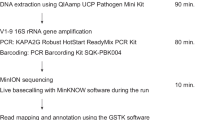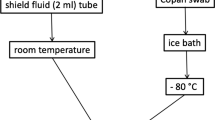Abstract
Forensic analysis of biological traces generally encompasses the investigation of both the person who contributed to the trace and the body site(s) from which the trace originates. For instance, for sexual assault cases, it can be beneficial to distinguish vaginal samples from skin or saliva samples. In this study, we explored the use of microbial flora to indicate vaginal origin. First, we explored the vaginal microbiome for a large set of clinical vaginal samples (n = 240) by next generation sequencing (n = 338,184 sequence reads) and found 1,619 different sequences. Next, we selected 389 candidate probes targeting genera or species and designed a microarray, with which we analysed a diverse set of samples; 43 DNA extracts from vaginal samples and 25 DNA extracts from samples from other body sites, including sites in close proximity of or in contact with the vagina. Finally, we used the microarray results and next generation sequencing dataset to assess the potential for a future approach that uses microbial markers to indicate vaginal origin. Since no candidate genera/species were found to positively identify all vaginal DNA extracts on their own, while excluding all non-vaginal DNA extracts, we deduce that a reliable statement about the cellular origin of a biological trace should be based on the detection of multiple species within various genera. Microarray analysis of a sample will then render a microbial flora pattern that is probably best analysed in a probabilistic approach.
Similar content being viewed by others
References
French CE, Jensen CG, Vintiner SK, Elliot DA, McGlashan SR (2008) A novel histological technique for distinguishing between epithelial cells in forensic casework. Forensic Sci Int 178:1–6
Paterson SK, Jensen CG, Vintiner SK, McGlashan SR (2006) Immunohistochemical staining as a potential method for the identification of vaginal epithelial cells in forensic casework. J Forensic Sci 51:1138–1143
Virkler K, Lednev IK (2009) Analysis of body fluids for forensic purposes: from laboratory testing to non-destructive rapid confirmatory identification at a crime scene. Forensic Sci Int 188:1–17
Schulz MM, Buschner MG, Leidig R, Wehner HD, Fritz P, Habig K, Bonin M, Schutz M, Shiozawa T, Wehner F (2010) A new approach to the investigation of sexual offenses-cytoskeleton analysis reveals the origin of cells found on forensic swabs. J Forensic Sci 55:492–498
Lee HY, Park MJ, Choi A, An JH, Yang WI, Shin KJ (2011) Potential forensic application of DNA methylation profiling to body fluid identification. Int J Legal Med. doi:10.1007/s00414-011-0569-2
Haas C, Klesser B, Maake C, Bar W, Kratzer A (2009) mRNA profiling for body fluid identification by reverse transcription endpoint PCR and realtime PCR. Forensic Sci Int Genet 3:80–88
Fleming RI, Harbison S (2010) The development of a mRNA multiplex RT-PCR assay for the definitive identification of body fluids. Forensic Sci Int Genet 4:244–256
Vennemann M, Koppelkamm A (2010) Postmortem mRNA profiling II: practical considerations. Forensic Sci Int 203:76–82
Virkler K, Lednev IK (2009) Raman spectroscopic signature of semen and its potential application to forensic body fluid identification. Forensic Sci Int 193:56–62
Sikirzhytskaya A, Sikirzhytski V, Lednev IK (2011) Raman spectroscopic signature of vaginal fluid and its potential application in forensic body fluid identification. Forensic Sci Int 193:56–62. doi:10.1016/j.fosciint.2011.08.15, in press
Costello EK, Lauber CL, Hamady M, Fierer N, Gordon JI, Knight R (2009) Bacterial community variation in human body habitats across space and time. Science 326:1694–1697
Kuczynski J, Costello EK, Nemergut DR, Zaneveld J, Lauber CL, Knights D, Koren O, Fierer N, Kelley ST, Ley RE, Gordon JI, Knight R (2010) Direct sequencing of the human microbiome readily reveals community differences. Genome Biol 11:210
Hyman RW, Fukushima M, Diamond L, Kumm J, Giudice LC, Davis RW (2005) Microbes on the human vaginal epithelium. Proc Natl Acad Sci U S A 102:7952–7957
Zhou X, Bent SJ, Schneider MG, Davis CC, Islam MR, Forney LJ (2004) Characterization of vaginal microbial communities in adult healthy women using cultivation-independent methods. Microbiology 150:2565–2573
Zhou X, Brown CJ, Abdo Z, Davis CC, Hansmann MA, Joyce P, Foster JA, Forney LJ (2007) Differences in the composition of vaginal microbial communities found in healthy Caucasian and black women. ISME J1:121–133
Thies FL, Konig W, Konig B (2007) Rapid characterization of the normal and disturbed vaginal microbiota by application of 16S rRNA gene terminal RFLP fingerprinting. J Med Microbiol 56:755–761
Hummelen R, Fernandes AD, Macklaim JM, Dickson RJ, Changalucha J, Gloor GB, Reid G (2010) Deep sequencing of the vaginal microbiota of women with HIV. PLoS One 5:e12078
Ravel J, Gajer P, Abdo Z, Schneider GM, Koenig SS, McCulle SL, Karlebach S, Gorle R, Russell J, Tacket CO, Brotman RM, Davis CC, Ault K, Peralta L, Forney LJ (2011) Vaginal microbiome of reproductive-age women. Proc Natl Acad Sci U S A 108(Suppl 1):4680–4687
White BA, Creedon DJ, Nelson KE, Wilson BA (2011) The vaginal microbiome in health and disease. Trends Endocrinol Metab 22:389–393
Hummelen R, Macklaim JM, Bisanz JE, Hammond JA, McMillan A, Vongsa R, Koenig D, Gloor GB, Reid G (2011) Vaginal microbiome and epithelial gene array in post-menopausal women with moderate to severe dryness. PLoS One 6:e26602
Brenig B, Beck J, Schutz E (2010) Shotgun metagenomics of biological stains using ultra-deep DNA sequencing. Forensic Sci Int Genet 4:228–231
Boon ME, Kok LP (2008) Theory and practice of combining coagulant fixation and microwave histoprocessing. Biotech Histochem 83:261–277
www.tno.nl. Accessed 6 January 2010
Dols JA, Smit PW, Kort R, Reid G, Schuren FH, Tempelman H, Romke BT, Korporaal H, Boon ME (2011) Microarray-based identification of clinically relevant vaginal bacteria in relation to bacterial vaginosis. Am J Obstet Gynecol 204(4):305–307
Cole JR, Wang Q, Cardenas E, Fish J, Chai B, Farris RJ, Kulam-Syed-Mohideen AS, McGarrell DM, Marsh T, Garrity GM, Tiedje JM (2009) The Ribosomal Database Project: improved alignments and new tools for rRNA analysis. Nucleic Acids Res 37:D141–D145
Nocker A, Richter-Heitmann T, Montijn R, Schuren F, Kort R (2010) Discrimination between live and dead cells in bacterial communities from environmental water samples analyzed by 454 pyrosequencing. Int Microbiol 13:59–65
Forney LJ, Gajer P, Williams CJ, Schneider GM, Koenig SS, McCulle SL, Karlebach S, Brotman RM, Davis CC, Ault K, Ravel J (2010) Comparison of self-collected and physician-collected vaginal swabs for microbiome analysis. J Clin Microbiol 48:1741–1748
Eschenbach DA, Patton DL, Hooton TM, Meier AS, Stapleton A, Aura J, Agnew K (2001) Effects of vaginal intercourse with and without a condom on vaginal flora and vaginal epithelium. J Infect Dis 183:913–918
Benschop CC, Wiebosch DC, Kloosterman AD, Sijen T (2010) Post-coital vaginal sampling with nylon flocked swabs improves DNA typing. Forensic Sci Int Genet 4:115–121
Sweet D, Lorente M, Lorente JA, Valenzuela A, Villanueva E (1997) An improved method to recover saliva from human skin: the double swab technique. J Forensic Sci 42:320–322
Fierer N, Jackson JA, Vilgalys R, Jackson RB (2005) Assessment of soil microbial community structure by use of taxon-specific quantitative PCR assays. Appl Environ Microbiol 71:4117–4120
Verhelst R, Verstraelen H, Claeys G, Verschraegen G, Delanghe J, Van Simaey SL, De Ganck GC, Temmerman M, Vaneechoutte M (2004) Cloning of 16S rRNA genes amplified from normal and disturbed vaginal microflora suggests a strong association between Atopobium vaginae, Gardnerella vaginalis and bacterial vaginosis. BMC Microbiol 4:16
Fleming RI, Harbison S (2010) The use of bacteria for the identification of vaginal secretions. Forensic Sci Int Genet 4:311–315
Witkin SS, Linhares IM, Giraldo P (2007) Bacterial flora of the female genital tract: function and immune regulation. Best Pract Res Clin Obstet Gynaecol 21:347–354
Yamamoto T, Zhou X, Williams CJ, Hochwalt A, Forney LJ (2009) Bacterial populations in the vaginas of healthy adolescent women. J Pediatr Adolesc Gynecol 22:11–18
Song Y, Kato N, Liu C, Matsumiya Y, Kato H, Watanabe K (2000) Rapid identification of 11 human intestinal Lactobacillus species by multiplex PCR assays using group- and species-specific primers derived from the 16S-23S rRNA intergenic spacer region and its flanking 23S rRNA. FEMS Microbiol Lett 187:167–173
Nakanishi H, Kido A, Ohmori T, Takada A, Hara M, Adachi N, Saito K (2009) A novel method for the identification of saliva by detecting oral streptococci using PCR. Forensic SciInt 183:20–23
Donaldson AE, Taylor MC, Cordiner SJ, Lamont IL (2010) Using oral microbial DNA analysis to identify expirated bloodspatter. Int J Legal Med 124:569–576
Power DA, Cordiner SJ, Kieser JA, Tompkins GR, Horswell J (2010) PCR-based detection of salivary bacteria as a marker of expirated blood. Sci Justice 50:59–63
Acknowledgements
We thank Frank Schuren, Anita Ouwens and Michel Ossendrijver (TNO Quality of Life, The Netherlands) for the development of the (vaginal) microbial flora microarray and Hans Korporaal for retrieving the 240 clinical samples from the archives of the Leiden Cytology and Pathology Laboratory (The Netherlands). We are thankful to the donors who provided the various types of samples and we thank Rolla Voorhamme for critically reading the manuscript.
Author information
Authors and Affiliations
Corresponding author
Additional information
Both C. C. G. Benschop and F. Quaak contributed equally. M. Boon is the pathologist responsible for the morphologic evaluation of the cervical brush samples.
Electronic supplementary material
Below is the link to the electronic supplementary material.
Supplementary Fig. 1
Overview of age pools with number of samples and reads per pool. Reads are grouped in genera represented by different colors. White bars represent Lactobacillus, green bars represent Gardnerella, other colours/genera are not specified (PDF 42 kb)
Supplementary Fig. 2
Distribution of next generation sequencing reads at genus level. Sequencing reads are based on 240 clinical vaginal samples and were assigned to genera using RDP. The percentages of sequence reads per genus are also incorporated in Supplementary Table 2 (PDF 148 kb)
Supplementary Fig. 3
Distribution of next generation sequencing reads assigned to species within the genus Lactobacillus. Sequencing reads are based on 240 clinical vaginal samples. A full overview of reads within the genus Lactobacillus is incorporated in Supplementary Table 3 (PDF 146 kb)
Supplementary Fig. 4
Total number of probes (A) and genera (B) detected using microarray analysis of NF and SF extracts obtained from the same swab (n=9). Genera assigned as Gram positive, Gram negative and Gram variable are shown as black, grey and white bars, respectively. (DOC 30 kb)
Supplementary Table1
Primer sequences used in various experiments (PDF 6 kb)
Supplementary Table 2
Percentage of next generation sequence reads on genus level based on 240 clinical cervical brush samples. Total number of sequence reads: 338,184 (PDF 8 kb)
Supplementary Table 3
Percentage of next generation sequence reads for Lactobacillus species based on 240 clinical cervical brush samples. Total number of Lactobacillus sequence reads: 199,433 (PDF 6 kb)
Supplementary Table 4
Percentage of samples per body site which were positive for a specific genus or family that was either detected in vaginal samples (vaginal +) or not detected in vaginal samples (vaginal-). A sample is regarded positive if at least one probe per genus or family is detected. For positive samples the number per total number of detected probes is shown for each genus (# of probes) (PDF 84 kb)
Supplementary Table 5
Distribution of 21 probes exclusively detected in vaginal DNA extracts. (A) Number (%) of vaginal DNA extracts detected per probe. (B) Number of probes detected per vaginal DNA extract (PDF 5 kb)
Rights and permissions
About this article
Cite this article
Benschop, C.C.G., Quaak, F.C.A., Boon, M.E. et al. Vaginal microbial flora analysis by next generation sequencing and microarrays; can microbes indicate vaginal origin in a forensic context?. Int J Legal Med 126, 303–310 (2012). https://doi.org/10.1007/s00414-011-0660-8
Received:
Accepted:
Published:
Issue Date:
DOI: https://doi.org/10.1007/s00414-011-0660-8




